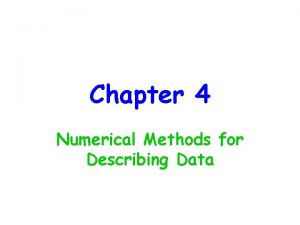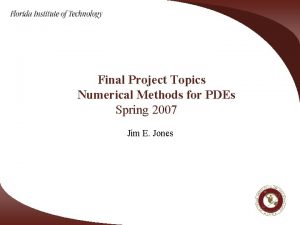Introduction to Numerical Methods for ODEs and PDEs







- Slides: 7

Introduction to Numerical Methods for ODEs and PDEs Lectures 1 and 2: Some representative problems from engineering science and classification of equation types

Strategy for the next four lectures Goal: to survey important considerations in the application of numerical methods to ordinary and partial differential equations in engineering and the sciences Topics: • Introduction to common types (with examples) of boundary value problems • Finite difference approximations – Integration of ODEs in time – Approximation of PDEs in time AND space • Finite Element methods

Motivation: Important BVPs and IBVPs in Engineering Science • Elastostatics (example of an elliptic PDE) • Elastodynamics (or the wave equation; example of a hyperbolic PDE) • The heat equation (a parabolic PDE) • Advective/diffusive behavior (example of a system which behaves like combinations of the above)

Elastostatics • Partial differential equation corresponds physically to balance of linear momentum of a differential cube, with no inertial terms present • Three dimensional statement of boundary value problem (BVP) requires two types (at least) of boundary conditions: force (Neumann) b. c. ’s, and displacement (Dirichlet) b. c. ’s • One dimensional analogue is a simple rod or truss problem • Classification of this system as an elliptic boundary value problem

Elastodynamics • Obtained by restoring the inertial term to the elastostatic system • Is an example of a (second order) Initial/Boundary Value Problem (IBVP), as both initial and boundary conditions are required to prescribe it • One dimensional analogue is the wave equation • Is the prototypical hyperbolic system (information propagates along characteristics)

Linear Heat Conduction (alternatively, mass diffusion) • Governing equation represents energy (alternatively, mass) balance in a differential control volume • Boundary conditions most often used specify flux (Neumann) or temperature (Dirichlet) • Example of a parabolic differential equation (information travels infinitely fast)

Linear Advection/Diffusion • An example of a system that displays characteristics of a hyperbolic system in one limit, and of a parabolic system in another • Will be used in our discussion of numerics (homework) to demonstrate concepts of stability and accuracy (and their limits!)













